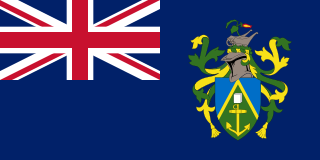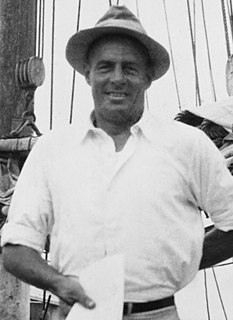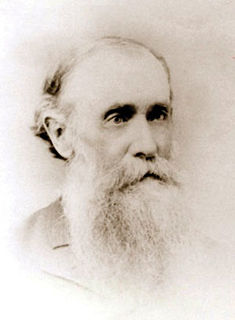
The Pitcairn Islands, officially the Pitcairn, Henderson, Ducie and Oeno Islands, are a group of four volcanic islands in the southern Pacific Ocean that form the sole British Overseas Territory in the Pacific Ocean. The four islands—Pitcairn, Henderson, Ducie, and Oeno—are scattered across several hundred miles of ocean and have a combined land area of about 18 square miles (47 km2). Henderson Island accounts for 86% of the land area, but only Pitcairn Island is inhabited. The islands nearest to the Pitcairn Islands are Mangareva to the west and Easter Island to the east.

Robert Louis Stevenson was a Scottish novelist, essayist, poet and travel writer. He is best known for works such as Treasure Island, Strange Case of Dr Jekyll and Mr Hyde, Kidnapped and A Child's Garden of Verses.

The mutiny on the Royal Navy vessel HMS Bounty occurred in the South Pacific Ocean on 28 April 1789. Disaffected crewmen, led by acting-Lieutenant Fletcher Christian, seized control of the ship from their captain, Lieutenant William Bligh, and set him and eighteen loyalists adrift in the ship's open launch. The mutineers variously settled on Tahiti or on Pitcairn Island. Bligh navigated more than 3,500 nautical miles in the launch to reach safety, and began the process of bringing the mutineers to justice.

The history of the Pitcairn Islands begins with the colonization of the islands by Polynesians in the 11th century. Polynesian people established a culture that flourished for four centuries and then vanished. They lived on Pitcairn and Henderson Islands, and on Mangareva Island 540 kilometres (340 mi) to the northwest, for about 400 years.

Fletcher Christian was master's mate on board HMS Bounty during Lieutenant William Bligh's voyage to Tahiti during 1787–1789 for breadfruit plants. In the mutiny on the Bounty, Christian seized command of the ship from Bligh on 28 April 1789. Some of the mutineers were left on Tahiti, while Christian, eight other mutineers, six Tahitian men and eleven Tahitian women settled on isolated Pitcairn Island, and Bounty was burned. After the settlement was discovered in 1808, the sole surviving mutineer gave conflicting accounts of how Christian died.

A ghost ship, also known as a phantom ship, is a vessel with no living crew aboard; it may be a fictional ghostly vessel, such as the Flying Dutchman, or a physical derelict found adrift with its crew missing or dead, like the Mary Celeste. The term is sometimes used for ships that have been decommissioned but not yet scrapped, as well as drifting boats that have been found after breaking loose of their ropes and becoming carried away by the wind or the waves.

The Tuamotu Archipelago or the Tuamotu Islands are a French Polynesian chain of just under 80 islands and atolls in the southern Pacific Ocean. They constitute the largest chain of atolls in the world, extending over an area roughly the size of Western Europe. Their combined land area is 850 square kilometres. This archipelago's major islands are Anaa, Fakarava, Hao and Makemo.

HMS Pandora was a 24-gun Porcupine-class sixth-rate post ship of the Royal Navy launched in May 1779. The vessel is best known for its role in hunting down the Bounty mutineers in 1790. Pandora was partially successful by capturing 14 of the mutineers, but wrecked on the Great Barrier Reef on the return voyage in 1791. HMS Pandora is considered to be one of the most significant shipwrecks in the Southern Hemisphere.

Henderson Island is an uninhabited island in the south Pacific Ocean. It is part of the Pitcairn Island Group, together with Pitcairn, Oeno, and Ducie Islands. Measuring 9.6 by 5.1 kilometres, it has an area of 37.3 km2 and is located 193 km (104 nmi) northeast of Pitcairn Island. It has poor soil and little fresh water, and is unsuitable for agriculture. There are three beaches on the northern end and the remaining coast comprises steep cliffs up to 15 m (50 ft) in height. In 1902, it was annexed to the Pitcairn Islands colony, which is now a British Overseas Territory.

William Frederick McCoy, also known as "Bill" McCoy, was an American sea captain and rum-runner during the Prohibition in the United States. In pursuing the trade of smuggling alcohol from the Bahamas to the Eastern Seaboard, Capt. McCoy, found a role model in John Hancock of pre-revolutionary Boston and considered himself an "honest lawbreaker." McCoy took pride in the fact that he never paid a cent to organized crime, politicians, or law enforcement for protection. Unlike many operations that illegally produced and smuggled alcohol for consumption during Prohibition, McCoy sold his merchandise unadulterated, uncut and clean.

The descendants of the Bounty mutineers include the modern-day Pitcairn Islanders as well as a little less than half of the population of Norfolk Island. Their common ancestors were the nine surviving mutineers from the mutiny on HMS Bounty which occurred in the south Pacific Ocean in 1789. Their descendants also live in New Zealand, Australia, and the United States.
Pitcairn Islanders, also referred to as Pitkerners and Pitcairnese, are the inhabitants or citizens of the Pitcairn Islands. The Pitcairn Islands are a British Overseas Territory, mainly inhabited by Euronesians of British and Tahitian descent.
James Russell McCoy served as Magistrate of the British Overseas Territory of Pitcairn Island 7 times, between 1870 and 1904. McCoy was among the first wave of settlers to return to Pitcairn from Norfolk Island in 1859. He was the son of Matthew McCoy and Margaret Christian. His son Matthew Edmond McCoy also served as Magistrate, and was among the last islanders to hold the surname McCoy. Through his daughter Adelia, he is a grandfather of Warren Clive Christian, and Ivan Christian, and a great-grandfather of Steve Christian and Brenda Christian.
Jack McLaren was an Australian novelist who wrote novels based on his life experiences and who was renowned for his "authenticity of background".

John I. Tay was a Seventh-day Adventist missionary who was known for his pioneering work in the South Pacific. It was through his efforts that most of the inhabitants of Pitcairn Island were converted to Adventism, and that the General Conference of Seventh-day Adventists purchased the Pitcairn schooner for missionary work in the South Pacific.

Pitcairn was a schooner built in 1890 for the Seventh-day Adventist Church for use in missionary work in the South Pacific. After six missionary voyages, the schooner was sold in 1900 for commercial use, and renamed Florence S. She was lost by stranding on the island of Mindoro, Philippine Islands, on 17 October 1912.

The complement of HMS Bounty, the Royal Navy ship on which a historic mutiny occurred in the south Pacific on 28 April 1789, comprised 46 men on its departure from England in December 1787 and 44 at the time of the mutiny, including her commander Lieutenant William Bligh. All but two of those aboard were Royal Navy personnel; the exceptions were two civilian botanists engaged to supervise the breadfruit plants Bounty was tasked to take from Tahiti to the West Indies. Of the 44 aboard at the time of the mutiny, 19 were set adrift in the ship's launch, while 25, a mixture of mutineers and detainees, remained on board under Fletcher Christian. Bligh led his loyalists 3,500 nautical miles to safety in the open boat, and ultimately back to England. The mutineers divided—most settled on Tahiti, where they were captured by HMS Pandora in 1791 and returned to England for trial, while Christian and eight others evaded discovery on Pitcairn Island.
"The Heathen" is a short story by the American writer Jack London. It was first published in Everybody's Magazine in August 1910, and later included in the collection of stories by London, The Strength of the Strong, published by Macmillan in 1914.
Ro-47 was an Imperial Japanese Navy Kaichū type submarine of the K6 sub-class. Completed and commissioned in January 1944, she served in World War II in operations related to the Mariana and Palau Islands campaign. She was sunk in September 1944 during her second war patrol.

Neilma Bailieu Gantner was an Australian philanthropist and author who wrote as Neilma Sidney.
















